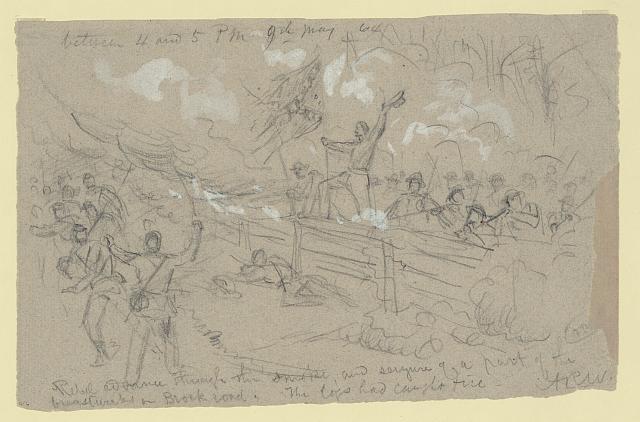I found the following article in The Weekly Democrat of Natchez, which was published on May 14, 1866. The writer was not identified, but whoever it was painted a graphic picture of Corinth one year after the war ended:
Not the least mentionable of the ‘pitched battles’ of the late war was that which was fought in front of this grand ‘intrenched camp’ that we call Corinth, on the 3d and 4th days of October, 1862. During the past two days a portion of my sojourn here has been spent as a partial exploration of that part of the battlefield which lies in the Northwestern angle formed by the crossing of the Memphis, Charleston, Mobile and Ohio Railroads.

The sight that I saw of vast numbers of Confederate ‘bones’ – whose skeletons and parts of skeletons – lying exposed and bleaching on the field, in the bushes and on the hillsides, under logs and on stumps; of the neatly enclosed and well marked graves of Federal soldiers, all buried at the proper depth; and of the forest trees rent in all directions, rent and torn by shot and shell, and the storm of ‘furious war’ and of many separate and distinct, desperate conflicts, hand to hand, and muzzle to muzzle; all of these ‘sights,’ I say, are well worthy of a brief record. Besides, I have another object in calling attention to the battlefield of Corinth apart from the gratification of public curiosity, and that is to urge upon our people the propriety of collecting the bones of their dead brethren, at some suitable spot near this place, and giving them decent interment. It is estimated by an intelligent gentleman of this town, that upon the two fields of Shiloh and Corinth, in this vicinity, there are not less than 12,000 ‘Confederate dead,’ whose bones for the most part, lie bleaching above ground!

Of all the Confederate dead on this field, Col. Rogers is, I am told, the only one who was buried deep enough to prevent the rains from washing the dirt away and exposing the bones. He, it is said, was buried under the immediate supervision of Gen. Rosecrans. In the North western angle, formed by the crossing of the railroads, from Corinth out to and beyond the outer line of works, three and a half miles distant, the whole of this great battle-ground is dotted, here and there – in some places thick as meadow mole-hills – with the graves of Federal and the exposed remains of Confederate dead.
The Confederate dead, it clearly appears, were merely covered up on the ground where they fell. The Federal dead were neatly interred, in the

usual way, with head and foot-boards in every instance, and in most cases, I believe, were enclosed with wooden palings. I saw but one Federal grave where the bones were at all exposed. I saw but one Confederate timulus where the bones – generally the skull – were not more or less exposed and scattered around in all directions. At the outer line of entrenchments, where a portion of Maury’s division made the assault, I saw two human skull bones, one pelvis, and two jaw-bones, lying on a stump, with no trace of a grave or timulus nearer than fifty or one hundred yards.
In front of the outer breastworks not far from the same spot, I saw two timuli, where some six or eight Confederate dead had been covered up on one side of a hill. Here several of the skulls and feet of most of the bodies had been uncovered by the action of the elements, and were lying around upon the ground, already bleached, perfectly white, and of course, rapidly crumbling to decay. The condition of these timuli, I am told by gentlemen residing in the vicinity who have examined every part of the field, is a fair specimen of all the rest. In one place (as I was informed by Capt. Mask, of this town, who, with Col. Polk, rode over the field with me.) The bodies of two or three Confederates were placed by the side of a log, (to save labor I suppose,) and a little dirt thrown over them; the dirt had all washed away, and there the skeletons lie, wholly exposed and uncared for, ‘like the beasts that perish!’
After reading this article, I have a better appreciation of why cemetery associations, created to properly bury Confederate dead, flourished in the post-war South. There was a terrible need for them.
